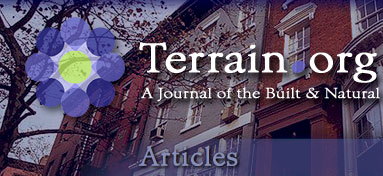
|
|||||||||||||||||||||
 |
|
|||||||||||||||||||||||||||||
|
|||||||||||||||||||||
|
by Kate Johnson As I drive into Corcoran, the fog is so thick it obscures my view of the opposite lane. At the side of the highway, a slab of blue-and-cream concrete looms suddenly out of the mist, like a pastel tombstone. I squint to make out an idyllic agricultural motif surrounded by assertive block lettering: Corcoran, Farming Capital of California. 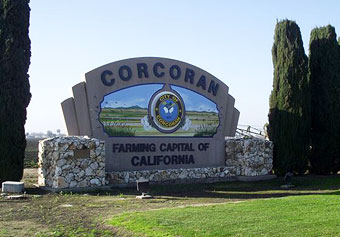 Corcoran's entrance monument. Photo by Kate Johnson. Fog is a hallmark of fall and winter in the California Central Valley. Sinking into a vast fissure between the coastal mountains and the rugged Sierra Nevada, it blankets the state’s wide highways and draws strings of curses from harried drivers. Less than 24 hours after my arrival in Corcoran, seven cars traveling along Interstate 5 collided in the fog. Visibility at the time of the crash was 300 feet. In 2007, an 86-vehicle pileup killed two motorists on nearby Highway 99, and two more died in a tangle of 74 cars on the same road several years earlier. Corcoran city manager Ron Hoggard warned me about the fog. When it rolls in thick, he says, some residents try to avoid the roads by taking a train from the small station in Corcoran’s downtown, north and west to San Francisco or south toward Bakersfield and Los Angeles. The trip from Corcoran to the Bay Area on Amtrak passenger rail takes six hours. But if California’s vision for high-speed rail had been a reality on that January morning, I could have boarded a train in Palo Alto and traveled to Corcoran at up to twice my car’s top speed. I could have slept, or read, or checked my email, as the train’s high-tech signaling system navigated along the tracks through the fog. I could have been in Corcoran in less than 90 minutes. But I couldn’t have stopped there. In the offices of the Corcoran Chamber of Commerce, a two-tier bookshelf holds a stack of white plastic binders. Three glossy spines bear the label “Cotton Festival” and a date, the typeset shifting subtly each October. The Christmas Celebration follows the Cotton Festival, and after the Christmas Celebration, in January, comes the Annual Banquet. In the summer, the Chamber sponsors an outdoor movie series and an ice cream contest. One fat binder, balanced precariously atop the pile, reads “Board Minutes.” 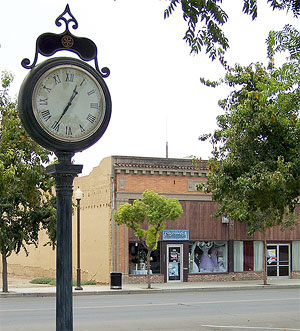 Downtown Corcoran, California. Photo courtesy City of Corcoran. The Chamber shares its western wall with Corcoran’s train depot, a tidy Spanish-style building constructed in 1999 to replace a century-old Santa Fe Railroad shipping facility. Twelve Amtrak passenger trains pull up outside the depot each day, six northbound and six southbound. State officials occasionally make the half-day commute to Corcoran from Sacramento on the train. Hoggard remembers one in particular, a woman who delivered a $2 million grant to the city. From her desk abutting the depot, Chamber member relations officer Lisa Shaw watches the flow of passengers through the parking lot. Seniors ride north to Hanford and return laden with shopping bags. Students leave in the morning for two nearby community colleges and complete schoolwork on the trip home. And former prisoners, released from the city’s two state penitentiaries, receive a one-way ticket to their county of origin. Like many towns of the American West, Corcoran grew out of the national railway system. The Santa Fe Railroad laid north-south tracks here in 1898. Eight years later, following the construction of a branch line toward Visalia, developer H.J. Whitley purchased the property known as “Corcoran Junction” and began the work of preparing the fertile land around Tulare Lake for large-scale farming. The rail junction grew into a shipping center, with a freight loading dock and a two-story station building that offered shelter from the hot Central Valley sun. Four trains a day left from Corcoran, carrying the region’s agricultural produce beyond the Valley. Now, the daily Amtrak service and the new train depot are among Corcoran’s emblems of pride and progress. Mayor Larry Hanshew believes that passenger rail is central to his town’s participation in the modern world. To take away the trains, says Hanshew, would be to take Corcoran “back to the Stone Age.” In a City Hall conference room, a framed portrait of the new depot hangs on the wall. A sweeping passenger train fills the picture’s background, dwarfing the small bright building under an azure Central Valley sky. Hoggard and Hanshew believe that high-speed rail will bring jobs and development to Corcoran. They hope that it will complement their existing transit options. But they also fear that the new trains will send their town back to the Stone Age at 220 miles per hour. 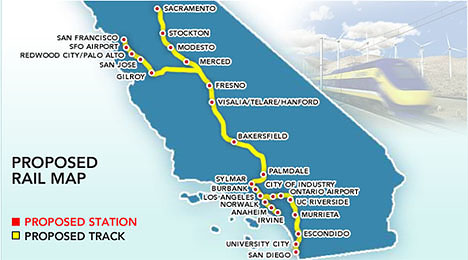 Proposed map for the California high-speed rail. Click image to access interactive map. Graphic courtesy California High-Speed Rail Authority. California’s high-speed rail proposal has evolved over years, even decades. Still no more than lines on a map, the 800 miles of track head south from San Francisco, twist eastward toward the Central Valley, and wind into Southern California through Bakersfield, Los Angeles, and Riverside before terminating in San Diego. A spur running north from Fresno connects the state capital, Sacramento, to the main line. With the system at full capacity, trains will run both north and south six times per hour. When the route crosses a road, the track will tunnel under—or climb over on an aerial platform up to 60 feet high. Aerial tracks might run for miles over dense street networks in major cities. Twenty-six rail stations line the proposed route, some already serving existing rail networks, others slated for construction or upgrade. The stations cluster tightly on the map near San Francisco and Los Angeles, and span broad, regular intervals in the Central Valley. Corcoran’s closest station would be near Hanford, 18 miles north. State officials envision the $40 billion project as a public-private partnership, half-funded by the federal government, the balance drawn equally from state coffers and private investors. In 2008, California voters passed Proposition 1A, approving state bonds to fund high-speed rail. California has now received more federal high-speed rail funding than any other state—over $3.5 billion. State funds bring the total committed to $5.5 billion. In December 2010, the California High-Speed Rail Authority announced its starting point for construction. The state’s first stretch of high-speed rail track will span 113 miles and will link Fresno, an hour north of Corcoran, to Bakersfield, an hour south. The section meets a federal requirement to spend grant funds in the Central Valley, where jobs in planning, construction, and maintenance could help relieve double-digit unemployment. But state officials might have chosen to start in the Valley regardless—land is inexpensive, an important factor for a government facing a $28 billion budget deficit, and the straight, flat topography will allow engineers to test the new system at top speed. Critics condemned the Authority for beginning the project far from California’s major urban centers, but Authority Board members emphasize they are building a system, not a single stretch of track. The starting point is immaterial, they explain, so long as the finished product links the entire state. Board member David Crane points out that the United States Interstate Highway System began not in a bustling American metropolis, but six miles west of Topeka, Kansas, with an eight-mile stretch of Interstate 70. 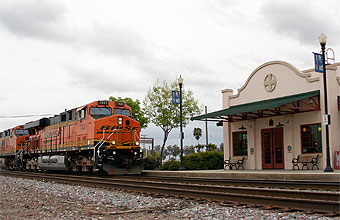 Corcoran's refurbished rail station. Photo courtesy Amtrak. And, Crane says, the Central Valley harbors the greatest civic enthusiasm for high-speed rail, enthusiasm that will allow the Authority to move quickly on the project without fighting costly legal battles. “The Central Valley is where the highest unemployment rates in California are,” Crane notes. While residents of the Bay Area and the coast protest that noisy trains and unsightly elevated tracks will blight their communities, Central Valley citizens “just are desperate to get it,” according to Crane. “They want transit-oriented development to arise from it. The Central Valley is where high-speed rail really passed, on the ballot. That’s where the greatest support was.” Several Central Valley cities did, in fact, fight to bring the first stretch of track inside their borders. But 2008 election returns contradict Crane’s assertion, suggesting that a majority of voters in the region have doubts about high-speed rail. Proposition 1A passed statewide with 52 percent of the vote. In many counties in the Bay Area and along the coast, the approval rate exceeded 60 and even 70 percent. But in Kings County, home to Corcoran and Hanford, just 48 percent of voters favored high-speed rail. To the east, Tulare County rejected 1A 45 to 55, and further north, in Tuolumne County, the measure failed 37 to 63. Even in Sacramento, a major urban center and a key terminus on the proposed route, less than half of voters supported state funding for the project. Of all counties in the Central Valley, only Fresno, Merced, and San Joaquin matched the state margin, approving the bond 55 to 45, 53 to 47, and 53 to 47 respectively. Both Hoggard and Hanshew know that even without a stop in Corcoran, temporary construction jobs will give the town a badly needed economic lift. In December 2010, Corcoran’s unemployment rate hit 17.4 percent, five points above the state average. The town’s leaders see the logic of starting in the Central Valley, where cheap land and fewer “not in my backyard” or NIMBY protestors make development easier. And they recognize wider benefits, including reduced traffic congestion and the convenience of fast, comfortable long-distance travel. But they also have real doubts, and a host of unanswered questions. “I believe in the high-speed rail system,” says Hanshew. “I think it’s going to make transportation so much easier for the Valley. But you have to back that up with some major concerns.” Hoggard echoes the Mayor’s sentiment. “We’re not against it,” he says. “It just needs to be done right.” How would that look, high-speed rail done right? Corcoran’s city manager of nine years leans forward earnestly, pressing his fingertips together. “We can’t lose anything that we already have.” 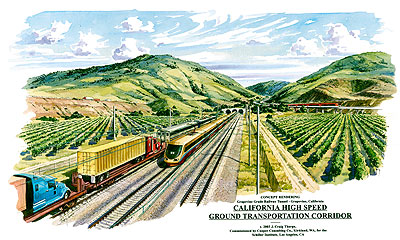 A 2003 rendering of the California High-Speed Ground Transportation Corridor as envisioned through Grape Valley, California. Graphic by J. Craig Thorpe. Ron Hoggard describes Corcoran as a “small town on the move.” Chain restaurants such as McDonald’s and Subway, relatively recent additions to the compact commercial district, stand out as symbols and catalysts of economic development. The Subway’s owner moved south to Corcoran from the urban sprawl of Fresno to open the business. He is active in the Chamber of Commerce, Corcoran’s natives note with approval, and he gives cookies to the local Boy Scouts when they stop by his door. Corcoran’s state prisons, constructed in 1988 and 1997, also represent progress. The prisons brought jobs and capital to the region, buffering oscillations in the local agricultural economy. While some of the state’s most dangerous criminals sleep within city limits, Corcoran’s residents take pride in the safety of their community. Crime rates in Kings County are around 20 percent below the California average. One resident complains about graffiti in Corcoran’s small downtown park, but notes in the same breath that she thinks the city has obtained a grant to reverse the damage. Ron Hoggard and Larry Hanshew both grew up less than 20 miles from City Hall. The two men left town after high school for college, war, and jobs in bigger cities. They returned years later with wives and children and advanced degrees in political science, administrative justice, sociology, and organizational behavior. “I said I’d never come back, and then I came back,” says Hanshew. He felt at home in Corcoran, assured of his daughters’ safety even when they walked alone at night. Asked if his children are still in Corcoran, he laughs and says no, they live in Visalia, ten times Corcoran’s size and an hour to the northeast. Corcoran, says Hanshew, will need a much better shopping district before he can convince his daughters to settle here. The off-the-cuff remark reflects real hopes for Corcoran’s future. This spring, city leaders expect to break ground on a new shopping center at the eastern edge of town. Hoggard has already overseen millions of dollars of redevelopment work in his nine years as City Manager. The city has upgraded storefront facades, installed planters along sidewalks and at intersections, and cut traffic on the main street, Whitley Avenue, to one lane in each direction. “We used to have two lanes, each way,” says Hoggard. “Zoom, zoom, people going through town. One lane each way, you can’t go faster than the person in front of you, even though you may want to. It slows it down. It makes it calmer.” He recalls a developer’s recent comment on Corcoran: “You have what a lot of places are trying to get back to.” In the Chamber of Commerce office, Lisa Shaw tells me that she thinks the majority of Corcoran’s residents have lived here for at least 20 years. “Almost everybody I know has some type of family ties,” says Shaw. “A lot came in as migrant workers, I think, and their families stayed.” She estimates that 50 to 60 percent of the Chamber’s businesses are farm-related. The Chamber board members have contemplated opening an interactive historical farming museum, to teach Corcoran’s younger generations about “the way it was.” 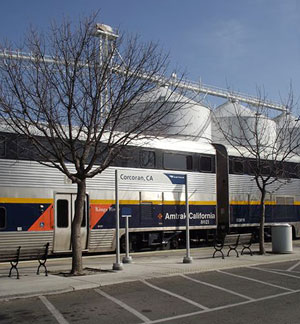 Amtrak passenger rail at the Corcoran rail station. Photo by Kate Johnson. In a broad sense, though, Corcoran’s agricultural character remains unchanged. Barrie Boyett, whose family has farmed the land east of town since the 1930s, guesses that roughly 80 percent of Corcoran’s residents work in agriculture either directly or indirectly. State data puts direct farm employment in Kings County at just ten to 15 percent, depending on the season, but no one in Corcoran disputes the industry’s importance to the community. “If it weren’t for agriculture, Corcoran would not be here,” says Boyett, a comment that resonates with the town’s past as well as its present. Farmers began growing beets and potatoes on Corcoran land decades before the city’s official incorporation in 1914. Today, agricultural employers range in size from Boyett’s family operation to behemoth J.G. Boswell. All of them, according to Hoggard, are integral to Corcoran’s economy and identity, not only providing jobs but also serving on local boards and committees and funding such projects as a community pool and an all-weather track for the local high school. Agriculture and rail are closely linked in Corcoran’s history, complimentary systems of production and distribution bringing income and significance to this small corner of California. Although he now targets local markets, Boyett still remembers loading grain onto freight cars for shipment. To the 75-year-old, though, Corcoran’s rail line is more than anything a feature of the landscape, built long before he was born. He works around the tracks, just as he works around the asphalt strip of State Highway 43, growing different crops on either side to avoid moving his equipment back and forth. He will not be so quick, he says, to work around high-speed rail. Boyett has heard of two possible routings for the new tracks, one closely paralleling the existing Santa Fe rail line through town, the other angling slightly east through his pistachio orchards. He has seen no official plans or maps, but he worries about the division of his property, and the effects on his irrigation systems. “I worked 50 years to bring this property up to where it is today, to make a nice entrance into Corcoran,” says Boyett. “And they’re going to destroy it.” He dismisses the supposed benefits. “How can it bring any economic development if it goes by Corcoran at 220 miles per hour?” And whatever the state offers for his land, he says, it won’t be enough to make the damage and inconvenience worthwhile. 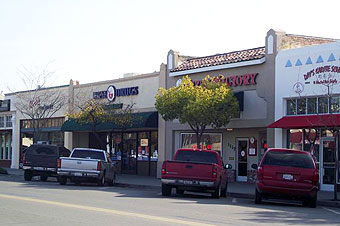 Newer facades and angled parking front retail buildings along Main Street, which was converted from four to two lanes in downtown Corcoran. Photo by Kate Johnson. Thus far, Boyett has kept his concerns largely to himself, waiting for government to approach him. But many Central Valley farmers have spoken out to legislators and the local press. They represent some of the most productive agricultural counties in the nation’s most productive agricultural state, and the issues they raise range from the tracks’ impact on wells and water pumps, to compensation for lost income, to effects on bee pollination. And despite state officials’ pledges to address their questions in forthcoming environmental impact reports, farmers remain frustrated with a perceived lack of attention to their concerns. Many, including Boyett, sense that they rank low on the state’s priority list. “My thought,” says Boyett, “is that this railroad is being designed for people in Los Angeles and the Bay Area.” To a large extent, agriculture’s problems are Corcoran’s problems. Hoggard believes that even residents who don’t work in farming might take an interest and a stand on behalf of the farm community. “But we’re not in lockstep,” he notes. Corcoran’s leaders have their own questions about high-speed rail, questions that relate more to the future of the town itself than to that of the farms on its borders. Hoggard worries about the effect the project will have on Corcoran’s revitalized downtown. He worries that the visual affront of an elevated track, and the noise of the trains, will undermine the security and the sense of community that attract businesses and residents. “They can’t put it at grade, coming through town. You have an elevated graffiti magnet.” He has heard that the sound of a high-speed train passing through Corcoran will measure 85 decibels. “That’s kinda high,” he says hesitantly, although in reality, the whistle of an Amtrak passenger train is no quieter. The more salient issue is the frequency. “If it’s every six minutes, up until midnight . . . I don’t know what that would be like.” Hanshew admits that residents complain about the noise of the Amtrak trains, too. “But there’s nothing they can do about it,” he explains. “They live here. I think they feel like they could do something about this.” The mayor has heard overwhelmingly negative responses to high-speed rail from Corcoran’s citizens. He believes that many simply fear change, and Hoggard agrees. Even the redevelopment work downtown met resistance at first. “If the state was more upfront with what they’re going to do, with what the towns will not lose, I think the citizens probably wouldn’t be as concerned,” says Hanshew, who has cultivated support for the new shopping center among conservative old-timers. But, like the agricultural community, Corcoran’s residents have struggled to elicit the information they need to feel secure. 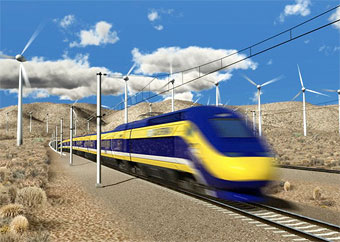 Rendering of the high-speed train, expected to travel at 220 miles per hour between Sacramento, San Francisco, Los Angeles, and San Diego. Graphic courtesy California High-Speed Rail Authority. For Hoggard, the largest unanswered questions relate to Amtrak. The passenger rail service receives about $90 million in state funding annually. An additional $1 to 2 billion still comes from the federal government, despite a lack of legislative enthusiasm toward funding a system that according to initial Nixon-era business plans should sustain itself through ticket sales. Amtrak’s ridership and revenues did increase markedly last year, especially in California—the San Joaquin route, which runs through Corcoran, is ranked fifth in the nation in ridership and enjoyed a two percent bump in 2010. But still, as Hoggard notes, “Everybody’s hurting for money.” The governor of California recently unveiled over $12 billion in budget cuts. Hoggard wonders: is the state really going to subsidize two train systems? Jeffrey Barker, deputy executive director of the California High-Speed Rail Authority, says that the new system will seek state subsidies only for construction, not for ongoing operations. His agency, he says, cannot speak to Amtrak’s funding. “As far as competition between Amtrak and high-speed rail in the Central Valley, high-speed rail will certainly have a strong competitive advantage because of travel time,” says Barker. He stresses, though, that the Authority sees high-speed rail as a complement to local and regional transit systems, not a replacement. But Hoggard and Hanshew wonder what will happen if high-speed rail does out-compete Amtrak. If farebox recovery rates—the percentage of operating costs covered by ticket sales—for the latter fall below a threshold considered sustainable by the state, will the depot building and the 12 daily Corcoran stops disappear? What would that mean for Corcoran’s elderly, for students constrained by time and money, or for others who can’t or don’t wish to drive the 18 miles north to Hanford? If the environmental review process postpones or eliminates the Hanford station, how many will find a way to make the hour drive to Fresno? What will developers, small businesses, and young families see in a town where trains fly past a hundred times a day, but never stop? “Maybe there are answers out there, and we haven’t heard them,” says Hoggard. “If they’re talking about it, they’re not talking about it very loudly, or very often. It’s a legitimate concern, and there are other stations along the way that will be affected. We’re not against it. But there are questions we need answered.” In keeping with their frustration at the lack of response, Hanshew and Hoggard also share Boyett’s impression that the Central Valley ranks second to the Bay and Los Angeles in the eyes of state planners. “If you take capacity away from the Valley, just to satisfy other people, that’s really not a good thing,” says Hanshew. Corcoran, Hoggard adds, appreciates the need for improved transportation in California. “But if our Amtrak goes away,” he says, “it’s not improved transportation. It may be great for LA, it may be great for San Francisco, but it will hurt us in the process.” 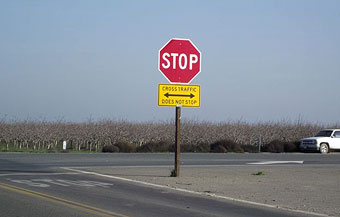 Road signage on the outskirts of town. Photo by Kate Johnson. Despite their skepticism, Corcoran’s leaders appreciate the Authority’s vision. “Not every train needs to stop here,” says Hoggard. “But you need to be able to take a train, in Corcoran . . . it needs to be a system that ties everybody together.” Hanshew believes that high-speed rail could benefit Corcoran. “What we would hope for,” he says, “is that high-speed rail would be a great addition to what’s already here. You don’t lose anything, it doesn’t really harm anything, and the city still stays as it is.” In a world of electrified lines and elevated tracks, where the Central Valley passes by the window at three hundred feet per second and an 800-mile journey shrinks to two billable hours, can a small town with a two-lane main street stay as it is without slipping behind? By the time I leave Corcoran, the fog has burned off, and pale January sunlight illuminates the carefully reconstructed storefronts on Whitley Avenue. I pause at the City Hall front desk, where Mayor Hanshew promised to leave a business card for me. The receptionist sees me and smiles. As I open my mouth to explain my business, she places the card in my hand. I drive out of town to the east, where the midday warmth lifts the pungent scent of fertilizer off of Barrie Boyett’s pistachio orchard. Blue letters six shades darker than the sky rise above Highway 43 to declare Corcoran’s place in California. And at the highway’s edge, facing the town’s concrete greeting, a much smaller black-and-yellow placard issues a warning to motorists: Cross traffic does not stop.
Post Comment
|
|
||||||||||||||||||||||||||||||||||||||||||||||||||||||||||||||
| Home : Archives : News Terrain.org : https://www.terrain.org Terrain.org is a publication of Terrain Publishing. |
||